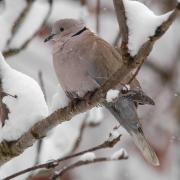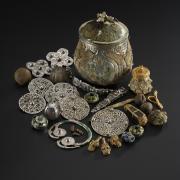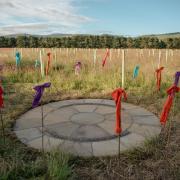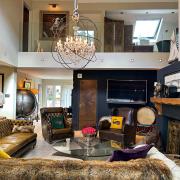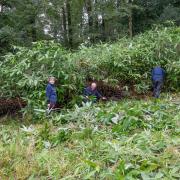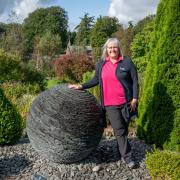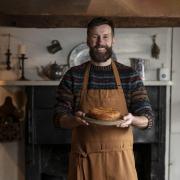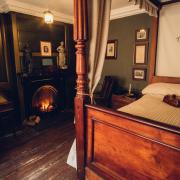'The opportunity to visit such a peaceful and happy place, while learning its history and secrets is something to be treasured,' writes Laura Jones, who discovers the delights of Dabton House and its enchanting garden, near Thornhill
Dabton House, near Thornhill is 200 years old. It was built in 1820 and made of the same pink sandstone as nearby Drumlanrig Castle.https://www.greatbritishlife.co.uk/magazines/dumfriesandgalloway/24329557.things-see-drumlanrig-castle-gardens/
Its garden, however, is centuries younger, having been created over the last 40 years to a modern brief.
It is a garden with a welcoming ambience that makes the visitor feel immediately at ease.
This could be because it was created as a family garden, not designed to overwhelm or impress but as a place for a children and adults to enjoy.
In 1982, the recently married Earl of Dalkeith and his wife, Elizabeth made Dabton their home, 10 minutes from the family seat at Drumlanrig.
There is where their four children grew up and went to school.
The couple planned their new garden and remained involved over the following 40 years - despite the demands of family and busy lives - so there is an immediate personal touch.
The relaxed feeling at Dabton could also be because John Candlish, who has been working there for 40 years, has a deep love for the garden and guides one around with the ease of someone who knows every nook and cranny.
John started as a garden apprentice within months of Dabton becoming the family’s home. Working under knowledgeable head gardeners, he learned his trade and was eventually appointed Head Gardener himself. In that time, an open space of four-acres was transformed into the garden we see today. To understand the background, we need to look back over 200 years.
Dabton House was built in 1820, as home for the Queensberry Estate’s factor. The Duke of Buccleuch was Scotland’s largest landowner, and his factor would have held a position of status. The factor’s home was designed in keeping with that status.
Beside the house was a large courtyard, which survives today. Old maps also show a formal garden beyond, with walls on two sides. However, by 1982, that garden had mostly gone but two vital elements remained – the old walls and surrounding woodland.
Drumlanrig Estate grows big trees and Dabton’s tall oaks and conifers provide shelter and an impressive skyline around the house and garden.
The garden is entered through gates bearing the famous Douglas family ‘winged heart’ crest.
A central path leads into the rose garden with a tennis court on the right. This is surrounded by a box hedge and a marquee can be sited here for events such as weddings.
The ground ahead rises gently toward the old walls, creating an amphitheatre effect. A stream flows down the centre, forming small ponds, edged with a superb collection of hostas. It is crossed by a bright red ‘Monet Bridge' which is a perfect viewing point for the waterlilies below.
Grassy banks rise up on all sides and are planted with a variety of shrubs and smaller trees, ensuring a range of seasonal change.
The rhododendrons and azaleas of spring give way to roses, viburnums, cornus and kalmia in early summer. The latter is known as the ‘calico’ flower and produces intricate and beautiful pink flowers.
As June gives way to high summer, the attention moves to the broad herbaceous borders at the top of the garden. The pink sandstone walls are a perfect foil for the unfurling colour and textures that are the glory of these well- planned borders.
As the season advances and that herbaceous glory wanes, shrubs and trees, such as acers and Amelanchier, pick up the garden’s music with fiery autumn colours.
Eventually the garden rests through winter, except for the green of holly and conifers.
When daylight lengthens, the first bulbs appear, snowdrops are succeeded by narcissi, then tulips, bluebells and the cycle starts over.
All the while, John and fellow gardener Steve Reid have been busy in the glasshouse, propagating and sowing. Come spring, they are ready to plant out vegetables. Meantime, the fruit trees, both wall-trained and in the orchard, are coming into bloom, as are the currants and berries.
This productive garden is a prominent part of the changes taking place at Dabton.
In 2020, with their children grown up, the Duke and Duchess decided it was no longer needed as their family home.
Buccleuch Estates has many interests and one of increasing importance is providing holiday accommodation. This is usually self-catering in estate cottages.
"Dabton House and Gardens are on a different scale which has given us lots more opportunities," says the Estate's operations manager, Alasdair Knight.
"Following a major renovation, we now have 11 en-suite bedrooms as well as reception rooms and a kitchen.
"In autumn and winter, we host guests who are booking shooting days on the estate. In spring and summer, we can accommodate large groups, often coming to celebrate events like birthdays and anniversaries.
"Guests may self-cater, dine locally, or we can provide catering in-house. Our Chef, Gordon Graham, and his team will use produce from the garden and from local suppliers.
With our own catering team and the marquee outside, we can also host weddings."
But their thinking goes further. Earlier this year, Dabton House teamed with Absolute Classics to provide a Musical Retreat. Music lovers stayed for the weekend, enjoying the playing of talented local musicians, as well as more established names.
And there are many more plans. The team at Dabton want the garden to remain accessible for all, as it always did under Scotland’s Gardens Scheme, and have offered guided garden tours this summer.
The opportunity to visit such a peaceful and happy place, while learning its history and secrets from Head Gardener, John, is something to be treasured.

















